Easy on the Job Tough the Elements Roofing or Roof
How to Roof a House
Our pros show you how to do it right—and save thousands!
![]() Time
Time
Multiple Days
![]() Complexity
Complexity
Intermediate
![]() Cost
Cost
Varies
Introduction
Follow along as we shingle a house from underlayment to ridge cap. The article includes detailed photos, drawings and clearly written instructions for every step of the job.
Tools Required
Materials Required
- #15 or #30 Felt underlayment
- Asphalt shingles
- Drip edge
- Hook blades
- Roofing nails
- Sealant
- Self-adhesive waterproof underlayment ("ice and water shield")
- Staples
- Step and dormer flashing
- Valley flashing
- Vent flashing
Can you roof a house yourself?
Make no bones about it—roofing is hard work. There's no hiding from the elements. You can't be afraid of heights and you need to be pretty fit. Before committing to this how to roof a house project, try this: Get out a ladder and climb up onto your roof. If you can't walk around on it comfortably, hire a pro. If you passed this first test, go to the lumberyard or home center and throw a bundle of shingles onto your shoulder. Imagine yourself carrying that load up a ladder…many, many times.
If you're still feeling positive about this how to roof a house at this point, why not give it a shot? You can skip a lot of heavy lifting by having your roofing supplier hoist the shingles onto the roof. Be sure you spread the load evenly across the length of the roof's peak. However, don't have the shingles delivered to the roof if you still have two layers of old shingles to tear off—it could be too much weight for your trusses.
After you've obtained a permit (if needed) and safely stripped the roof clean, nail drip edge flashing flush along the eave.
Windblown heavy rain and/or snow can force water up and under even properly installed shingles. Even worse are ice dams (frozen water/snow that builds up on roof edges), which can wreak havoc by allowing water to seep up under lower shingles and then drip into your house. To guard against such seepage, apply self-adhesive waterproof underlayment ("ice barrier"), which adheres tightly to bare roof sheathing and seals around nails driven through it. Buy it at roofing supply companies or home centers. In severe climate regions, most building codes require applying it 3 to 6 ft. up from the eave (minimum of 2 ft. past the exterior wall). Call your building inspector for local details.
Cover the rest of the roof with No. 15 asphalt-saturated felt underlayment (some codes may require No. 30). Each layer overlaps the lower one by at least 2 in. Follow this step by nailing drip edge along rakes (sides of roof), on top of the underlayment. As you did with the flashing, always lap upper pieces over lower pieces. The felt keeps the roof deck dry before shingles go on, protects against wind-driven rain as shingles fail and increases fire resistance.
Next, find the center of the roof at the top and the eave, then snap a vertical chalk line. Most pros use this line to begin shingling, working left and right toward the rakes. Shingle manufacturers may recommend starting at the left rake edge, so check package recommendations.
For the first row of shingles, called a starter course or strip, you cut the tabs off three-tab shingles and apply them with the self-sealing adhesive strip facing up along the eave. Make sure this row has a slight overhang (1/4 to 3/8 in.) beyond the drip edge. The starter course protects the roof by filling in the spaces under the cutouts and joints of the next row (first course) of shingles. The adhesive on the starter course seals the tabs of the first full course.
Finally, nail the first course of shingles directly on top of and flush with the starter course. Use four roofing nails per shingle, as indicated on package instructions (six nails in high-wind areas). Once this course is laid, you can begin snapping horizontal chalk lines up the roof to ensure straight rows. Make sure to expose 5 in. of the shingle tabs where the bottom edge of the tab meets the top of the cutout.
Tear off the old shingles
It's impossible to properly install new flashing and underlayment if you don't tear off the old roof beforehand. When tearing off the existing shingles, be sure to remove all the old nails or pound them flat. Protruding nails will tear holes in your new shingles. If you have movable items near your house and you're worried they might get damaged, relocate them. Invest in a few large tarps to protect your plants and landscaping and to catch the thousands of nails that will rain down off the roof. It can be downright impossible to remove old self-stick ice-and-water underlayment, but it's OK if you have to leave it in place. And if at all possible, have the rented trash bin parked close to the house so you can toss in the old shingles right from the roof.
Figure A: Roofing Overview

This cutaway drawing shows the steps involved in roofing a house.
Install the drip edge
Metal drip edge isn't usually required (check with a local building official), but it gives roof edges a nice finished look, prevents shingles from curling over the edge, and keeps water from running directly down your fascia boards.
Before you install the underlayment, fasten the drip edge that covers the fascia on the eaves. The whole length of the fascia is probably not perfectly straight, so don't snap a line; just hold the drip edge snug against the fascia and fasten it through the top into the decking with roofing nails. Nail it every couple of feet.
Install the drip edge on the gable ends of the roof after you finish installing your underlayment. Start at the bottom side of the gable, and overlap the sections of drip edge a few inches as you work your way up the roof (see Figure A). Use a tin snips to cut the drip edge to size.
Stay Safe
When it comes to roofs, even the best safety equipment is no substitute for common sense and good judgment. Here are some tips for working safely on a roof:
- Leave steep and/or high roof work to the pros. No amount of money you could save is worth the risk of death or a lifelong disability from a fall.
- A fall protection kit (harness, rope and hook) only costs about $100 at home centers.
- Wet roofs are slippery. Wear shoes with soft rubber soles for extra traction.
- Keep the roof swept clean of dirt and debris.
- Everyone on the ground should wear a hard hat—even the most careful worker can drop a tool off the roof.
- Always look and call out before tossing anything down.
- Carefully position ropes and extension cords so they're not underfoot.
- Check the weight rating on your ladder—it needs to hold you plus 80 lbs.
- Extend the top of the ladder at least 3 ft. above the roof edge so you'll have something to hang on to as you step onto and off the roof.
- Never step on any of the ladder rungs above the roof.
- Set up scaffolding to install the drip edge and first few courses.
Project step-by-step (15)
Step 1
Roll out the self-stick underlayment
Stick on the underlayment
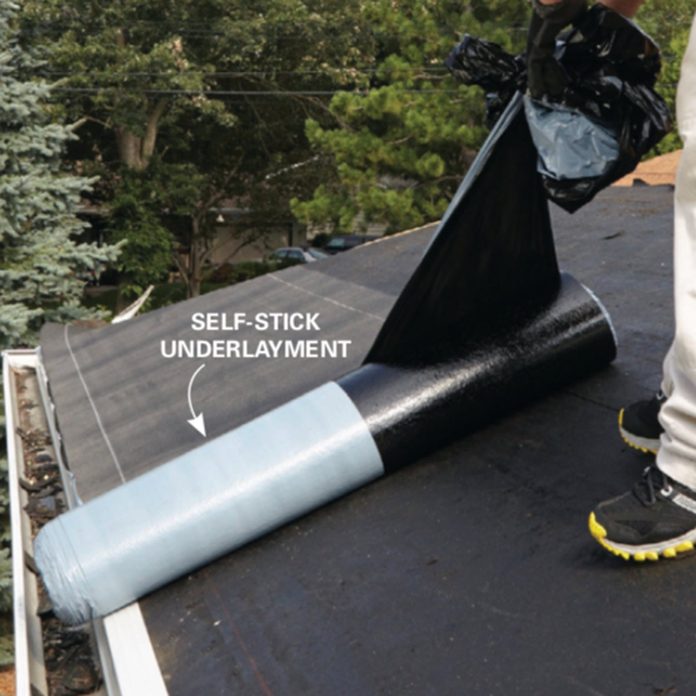
Protect the roof against ice dams and windblown rain with self-stick ice-and-water underlayment. Peel off the top half of the plastic backing as you unroll the underlayment.
Step 2
Peel off the bottom backing
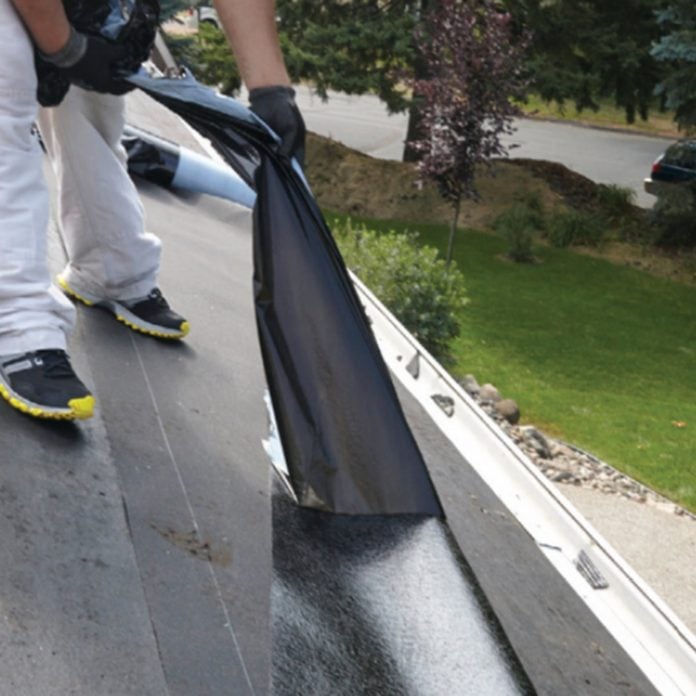
Make sure the underlayment lies smooth before you nail the top edge. Then pull off the lower half of the backing.
Stick the bottom part of the underlayment to the roof of the house.
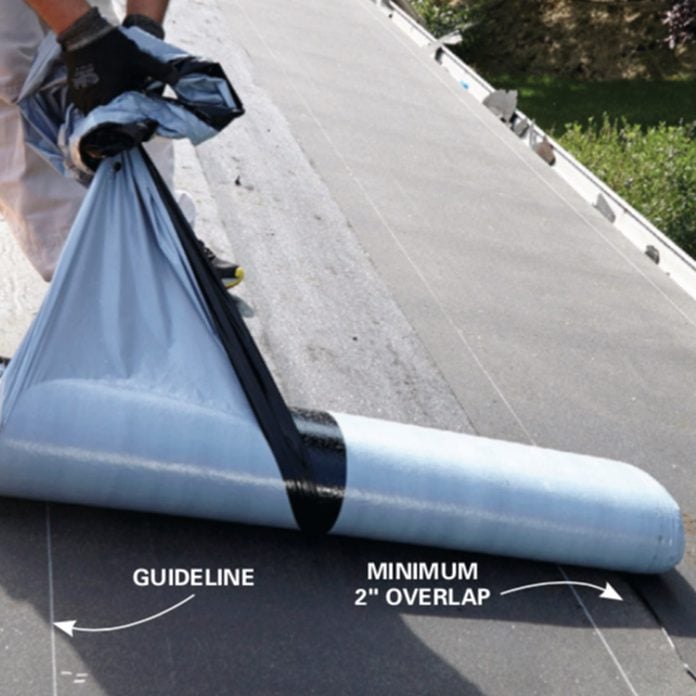
Install the second course just like the first, using the guidelines on the underlayment to get the correct overlap. When an ice dam forms on a roof (usually caused by poor attic insulation/ ventilation), ice and water can work their way up under the shingles and leak back into the house. Also, strong winds can blow rainwater under shingles. Self-stick roofing underlayment (often called "ice-and- water" underlayment) can prevent this because it sticks to the roof decking to seal out water. It also seals around nails, which keeps water from leaking through nail holes.
Rolls of self-stick underlayment have a plastic backing so the material won't stick to itself. The backing is separated down the middle. Line up the lower edge of the roll with the outside of the drip edge. Peel back part of the uppermost backing on the roll, and nail the top corner of the underlayment to the decking. Start pulling the roll across the decking using the backing, making sure the material is lying as flat and as straight as possible as you pull.
You'll be able to roll out long sections at a time if you have a low-pitched roof, but the underlayment may slip off the eaves on steeper roofs, so roll out no more than 10 ft. there (Photo 1). It's important to make sure all your underlayment lies flat before you fasten it to the decking. Ripples and lumps can telegraph through the shingles and may be noticeable from the ground.
On warm days, self-stick underlayment will stick to clean decking without any fasteners. Fasten it to the roof with staples or nails on colder days, but only fasten the top part of the underlayment until you go back and peel off the bottom half of the plastic backing (Photo 2). The higher the temperature outside, the stickier the adhesive on the rolls gets. This ice-and-water underlayment is tricky to work with on super-hot days; keep that in mind when you plan your project.
Many severe climate areas require self-stick underlayment to be installed at least 2 ft. in from exterior walls. This means you'll need two rows if you have 2-ft. eaves. Any two sections of underlayment on the same row should overlap a minimum of 6 in., and each course should cover at least 2 in. of the one below it (Photo 3). These rules can vary, so always consult your local building official.
Step 3
Cover the roof with felt paper
Roll on the felt paper
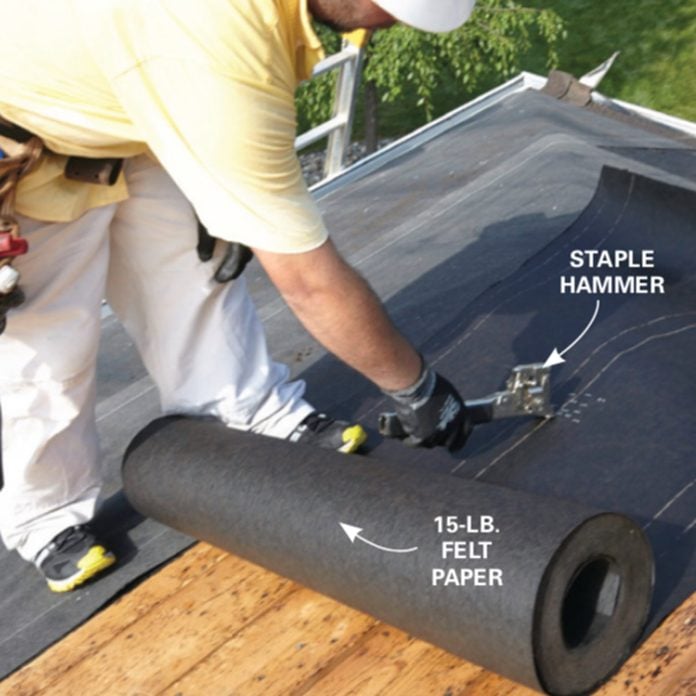
Cover the roof above the underlayment with roofing felt paper. To start each course, drive a dozen staples grouped close together. Then unroll the felt and straighten out the row before you add more staples.
Step 4
Don't skimp on staples
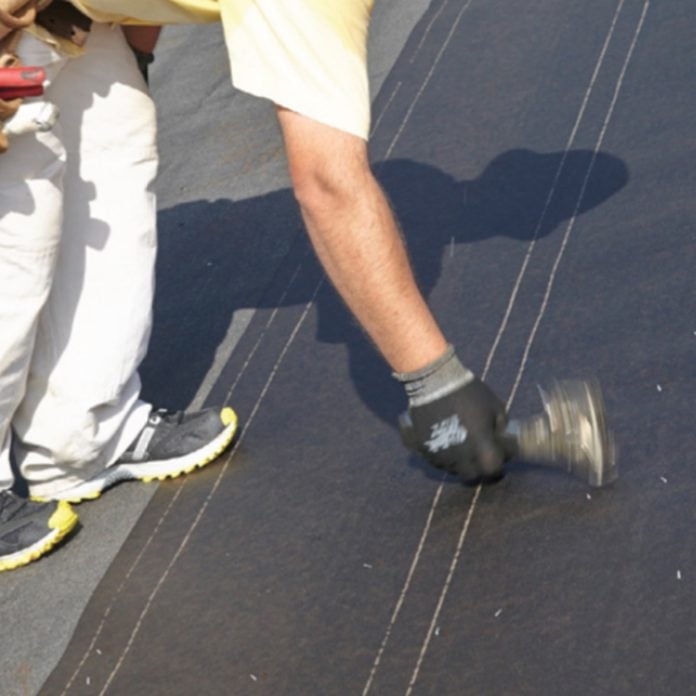
Place staples no more than 12 in. apart. Paper with too few staples will tear out under your feet and could cause a fall.
Step 5
Overlap the ridge
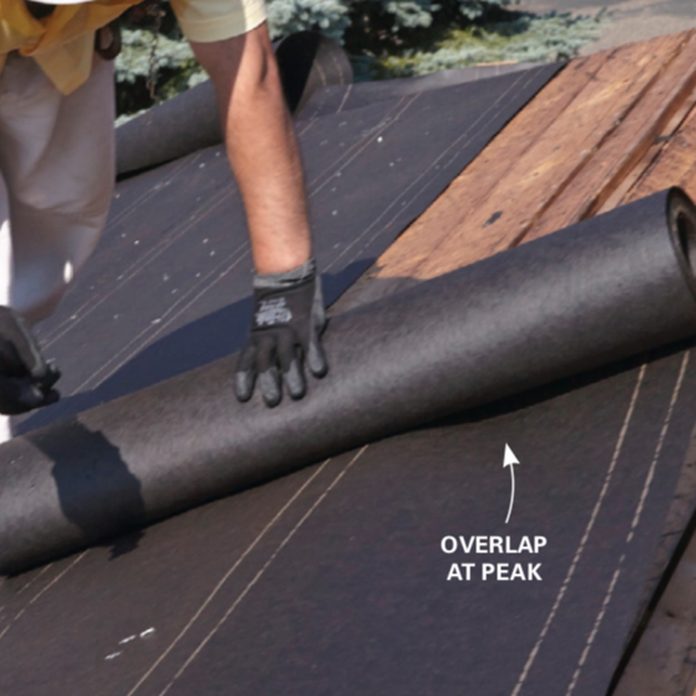
Run the felt paper over the peak and overlap it onto the other side. Do the same when you reach the peak from the other side of the roof.
Felt paper, also called tar paper or builder's paper, helps shed water that gets under the shingles, protects the asphalt shingles from the resins in the wood decking, increases a roof's fire rating and helps keep your house dry if it rains during the job. Most roofing suppliers carry 15-lb. and 30-lb. rolls of felt. For most applications, 15-lb. felt works just fine. Install 30-lb. felt if you plan to leave the paper exposed for more than a couple of days because it wrinkles less then 15-lb. And 30-lb. felt doesn't tear as easily, so it's safer to walk on when you're working on steeper pitches.
Start a row by rolling out a short section of paper and securing it with a dozen staples grouped together near the center of the paper (Photo 4). That way you'll then be able to roll out a long section and swing it back and forth until your overlap is even. Each row of paper should overlap the one below it at least 2 in. There will be overlap lines printed on the paper to guide you. Overlap seams on the same row 6 in.
Practice on a couple of 10-ft. sections until you get the hang of it, and don't roll out a 25-ft. section of paper on a steep roof or when it's windy. If you're fastening the paper with a staple hammer, try to get a staple in every square foot of the paper (Photo 5). That may seem like a lot, but insufficiently stapled paper can tear out under your feet, which could result in a fall. Don't walk on any paper that isn't completely stapled down. Fasten the felt with cap staples/nails if you're working on a windy day or are working on a roof with a pitch steeper than 6/12.
When you reach the top of the roof, run your last row long (Photo 6), and drape the paper over the peak (top ridge) onto the other side. When you reach the top on the other side of the roof, run that paper up and over as well. That way you'll end up with a watertight ridge. Your local building official may want to come out to inspect your roof at this point, but sometimes you can get by with snapping a few photos. Ask about the inspection schedule when you pick up your permit.
Step 6
Waterproof your valleys
Flash the valleys
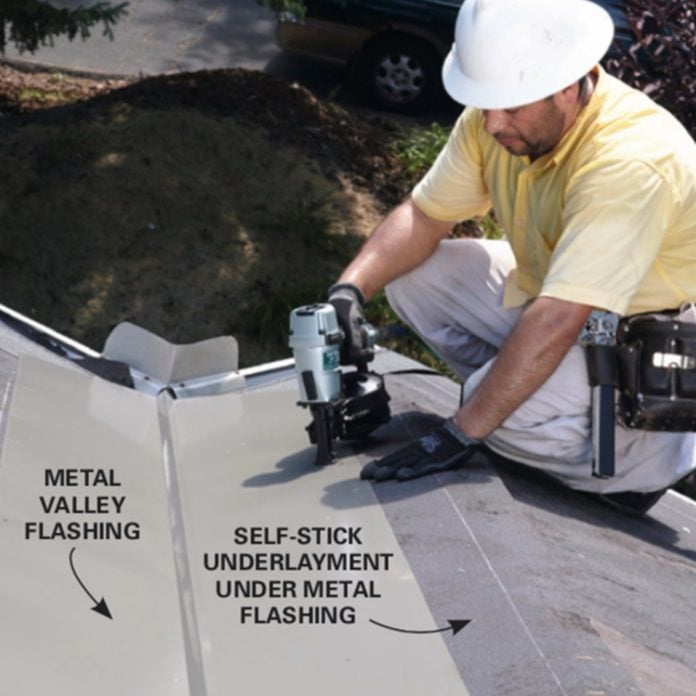
Install self-stick underlayment under the metal flashing. If you need more than one flashing in your valley, lay them both in place and make sure they're straight before nailing them down.
Step 7
Fold flashing over the peak
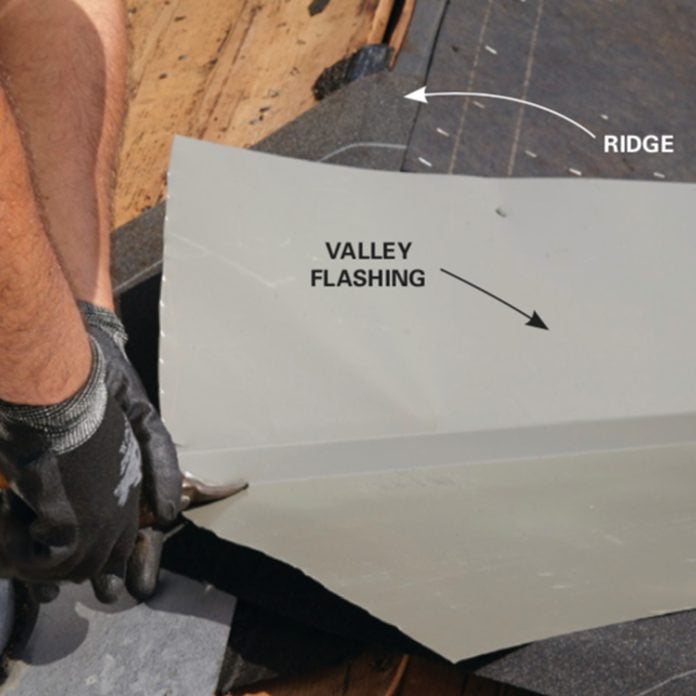
Cut the flashing back to the peak along each crease. Then fold the flashing over the peak and cover the cut ends with self-stick underlayment. Roof valleys channel a lot of water, so they need extra protection. Start by installing self-stick underlayment on the decking. This process is much easier with two people. Cut the underlayment to size (or in sections for long valleys), and peel off the entire plastic backer. With a person on each end, fold the underlayment in on itself, sticky side out. Then lay it into the valley and unfold it. Try to push it down into the crease of the valley as tightly as possible. If this self-stick ice-and- water underlayment bridges both sides of the decking, leaving a gap underneath, it could tear once you install the metal valley flashing. Run the underlayment past the drip edge at the eaves, and trim off the extra with a utility knife. Once it's smooth, nail it down on the outside edges.
Finish installing felt paper on the rest of the roof, overlapping the self-stick underlayment. Be careful when you trim back the felt paper so you don't slice into the underlayment. Photo 7 shows the underlayment covering the felt on one edge a couple of inches. This will keep water farther away from the inside corner of the fascia. You can extend the center out even more but not so far that water overshoots your gutters if you have them.
Be careful not to nail your shingles any closer than 8 in. from the center of the valley. Once all the shingles are installed, snap lines as guides to trim them off. There should be 6 in. of the valley exposed on top (3 in. on each side), and each side of the valley should widen 1/8 in. for every linear foot of the valley run. So, if you have a valley run of 16 ft., your valley exposure would be 6 in. on the top and 10 in. on the bottom.
Another way of dealing with valleys is to use the "weave" method, which we don't cover in this story. The shingles are woven together from both sides of the valley. The benefit of a woven valley is that it doesn't leave an exposed flashing, which results in a cleaner look. The downfall is that leaves and twigs don't get washed away as easily, which can cause little water dams. This is especially true for roofs with low pitches.
Avoid Extreme Temperatures
Avoid roofing your house in below-freezing temperatures. The shingles won't stick together, which makes them prone to wind damage. A couple of cold days won't cause trouble, but after weeks and months, the adhesive strips on the shingles can attract dust and fail to seal even when the weather does warm up. And try to avoid working on sunny days when the temperature is above 90 degrees. The ice-and-water underlayment gets overly sticky and difficult to work with, and the shingles get soft and are easily scuffed by feet and tools.
Step 8
Begin with starter shingles
Install starter shingles
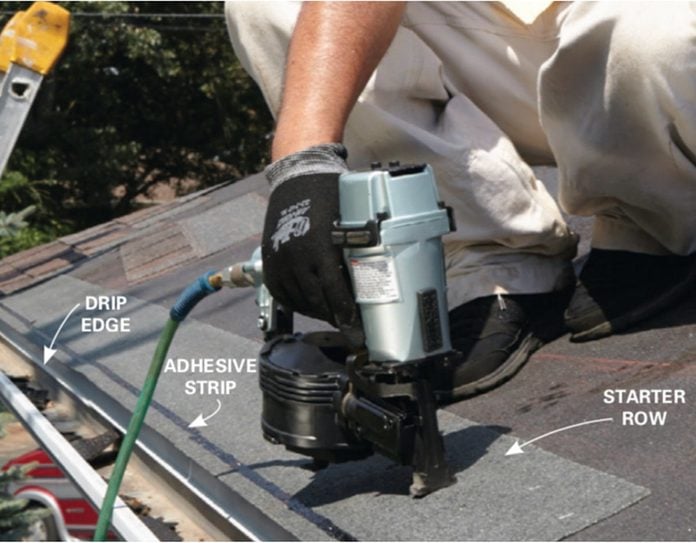
Run the row of starter shingles 1/2 in. past the drip edge. Position them so the adhesive strip is toward the bottom and facing up. Place nails 2 to 3 in. up from the bottom of the eave. Water can get in the seams between any two shingles, but that's OK because shingles overlap and the seams are staggered. But if you don't use starter shingles, water will run in between the seams on the first row and right onto the underlayment, increasing the odds of a leak. The starter row shingles are only half as wide as a full shingle. If they were full size, the top half of the first row would have three layers of shingles instead of the two the rest of the roof has, causing a visible hump.
Don't bother snapping lines for the starter shingles; just overlap them 3/4 in. past the drip edge. Fasten them down with five nails about 2 to 3 in. up from the bottom of the eave. Position the starter shingles so the adhesive strip is toward the bottom and facing up (Photo 9). The adhesive strip bonds to the shingle above it, creating a nice tight seal, reducing the chance of wind damage and water infiltration.
Some pro roofers install starter shingles on the gable ends as well. It's not usually required, but it provides a cleaner look. Hang gable-end starter shingles 1/2 in. past the rip edge, and make sure you overlap the starter shingle on the eave by 2 to 3 in.
Rent or Buy?
Unless your roof is tiny, you're going to want to get your hands on a pneumatic roofing nailer. Prices range from $100 to $300. Renting one costs about $35 a day or $90 a week, so if you own a compressor, you might as well buy rather than rent. A compressor rents for about the same as the nailer. If you don't own a compressor and know you're going to finish your house in less than a week, then renting is probably the way to go.
If you do buy a roofing nailer and you know you'll only use it for one job, a cheaper model will work just fine. It just won't be as durable as the high-end models the pros use. But don't tell anyone you bought it. If the word spreads that you're a roofing gun owner, you run the risk of being recruited by a whole bunch of friends and neighbors to help work on their roofs.
Step 9
Install the shingles
Nail on shingles
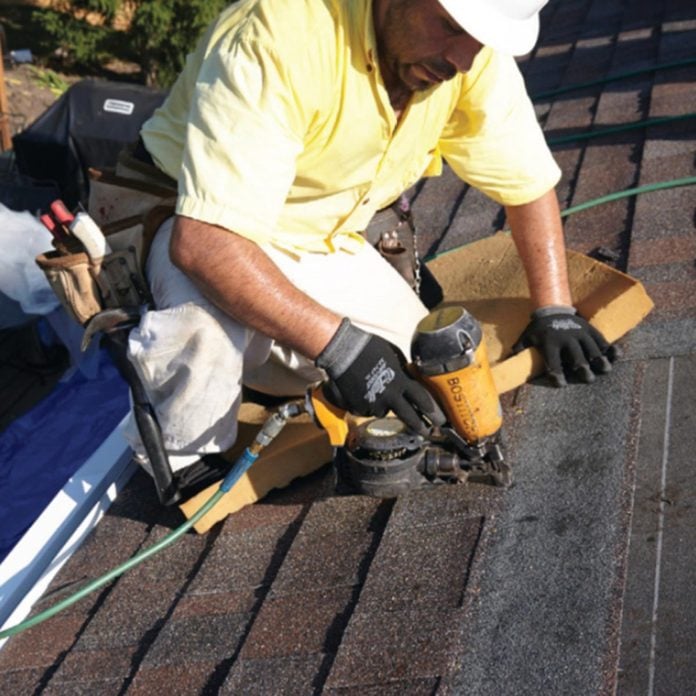
Following the manufacturer's nailing instructions is critical; improper nailing is the biggest cause of roof failures in storms. Where and how often you nail your shingles will depend on wind speeds in your area and the pitch of your roof.
Step 10
Run shingles long, then trim them off
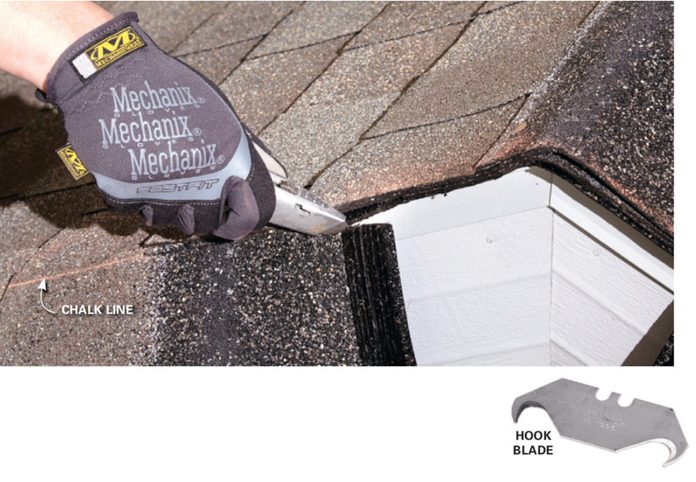
For nice straight lines, run shingles over the edge of the roof. Then snap a chalk line and trim them off with a hook blade in your utility knife. If the overhang is more than a foot, cut some off and use the remainder elsewhere.
Hook blade
Hook blades are used for cutting shingles. They fit into any standard utility knife just like straight blades. Laying shingles isn't easy, but it's probably the simplest part of roofing a house. Line up the bottom of the first row of shingles with the bottom edge of the starter row, making sure the seams are staggered. With that row complete, you'll need to figure out the reveal (the portion of the shingle that isn't covered by the one above it). Standard reveals vary between 5 and 6-1/2 in. Whatever the reveal is supposed to be, snap a horizontal line that distance from the top of the first row of shingles (see Figure A, above).
Your roofing gun should have an adjustable guide to help keep the rows straight. If it doesn't, cut a block of wood the same size as your reveal and use that as a gauge. Slightly wavy rows won't be noticeable from the ground, so only snap lines every several rows to straighten things out. It's easier to work from right to left if you're right-handed. Stagger each row so the seams don't line up. Follow the stagger pattern recommended by the manufacturer of your shingles. Use partial shingles to start subsequent rows.
No one will notice if the last rows are not the same size on both sides of the ridge, but it can be very noticeable if the row that meets the ridge has a 4-in. reveal on one side and a 1-in. reveal on the other. Once you get within 8 ft. of the ridge, measure down to your shingles at each end of the row. If one side is closer to the peak than the other, snap lines for all the remaining rows, making the reveal on one side progressively larger until you make up the difference. Don't adjust any row by more than 3/16 in.
Every shingle brand has its own nailing pattern requirement. The pitch of your roof and the wind conditions in your area also affect how many nails to use and where. Most shingles require four to six nails, about 1 in. in from each side and placed so they get covered at least 1 in. by the shingle above them. The nails should penetrate the decking at least 3/4 in. Most pros use 1-1/4-in. zinc-coated roofing nails.
Nail straight into the shingle, and adjust the setting on your gun or the pressure on your compressor so the nails pull the shingle tight to the decking but stay flush with the surface. Keep a hammer close at hand to take care of nails that get only partially driven in. And never use staples! Even if a buddy has an old roofing stapler with free staples, politely decline. Staples don't have the holding power of nails; they tend to rust out before the shingles go bad; and most manufacturers don't allow staples, so you'll void the warranty.
When you reach the ridge, use the same technique as you did with the felt paper: Wrap the first side over the top, and then wrap the second side over the first. Cut the shingles to size with a utility knife fitted with hook blades. Run the shingles long over hip ridges and rakes, and in the valleys. When you're all done installing the shingles, snap lines and trim the shingles to the line (Photo 11).
Architectural vs. Three-Tab Shingles
The shingles shown here are commonly called "architectural." Some architectural shingles are partially laminated (two layers), and others are fully laminated, which gives them more of a textured look, similar to wood shakes. Because of the extra material, architectural shingles are heavier. Some can handle winds up to 150 mph, which is twice the wind rating of many three-tab shingles.
Architectural shingles are easier to install because you don't have to worry about lining up the tabs vertically. The life span depends on the quality of the shingle. Both styles are available with 25-year and 30-year warranties. Expect to pay about 15 to 20 percent more for standard architectural shingles than for standard three-tabs.
Whichever you choose, make sure all the bundles have the same "lot" number on the packaging. That means they were all made in the same batch or run. Shingle color can vary noticeably from one batch to another.
Install step and dormer flashing
It's possible to reuse existing step flashing and dormer flashing, but the best way to get a watertight seal is to tear off the siding in those areas and install new flashing. Start by running self-stick underlayment at least 6 in. up onto the walls. This provides an additional barrier if water does get past the flashing. Cover the front wall first and then work your way up the side wall. Overlap the sidewall underlayment around the corner onto the front wall about 1 in. or so.
Install the shingles right up to the front wall. Cut a couple of inches off the vertical portion of the dormer flashing, and run the horizontal portion past the side wall that same distance. Nail the dormer flashing to both the wall and the shingles.
Make a 1- to 2-in. cut with a tin snips at the bend in the first step flashing. Run a bead of sealant on the corner edge of the dormer flashing, and then run that step flashing past the dormer flashing the same distance you made your cut. Bend the step flashing around the corner onto the dormer flashing with your hammer.
Install your next row of shingles over that first step flashing, then cover that row with a step flashing, and so on. Nail the step flashing to the wall toward the top of the flashing at the end that's closer to the peak, so the next step flashing in line will cover the nail. Don't nail them down through the shingles. For information about flashing around chimneys, see Installing Chimney Flashing.
Figure B: Step and Dormer Flashing
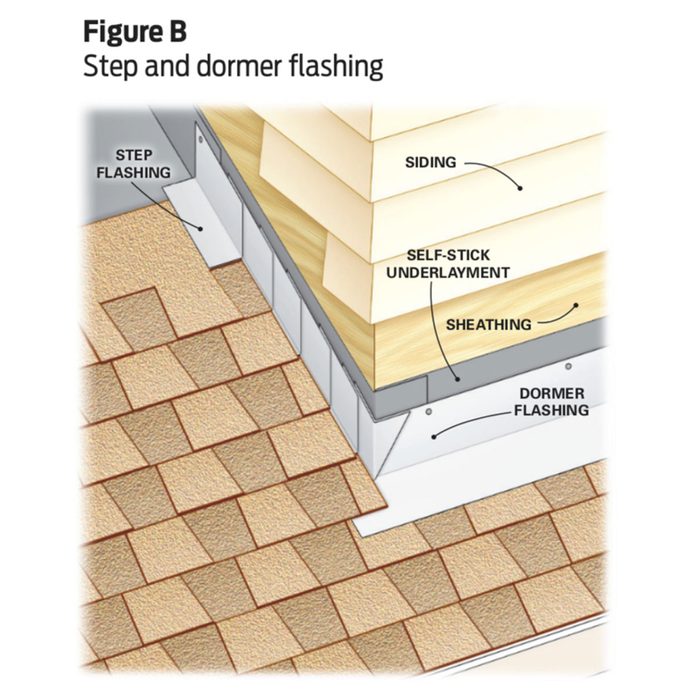
Weave the step flashing and the roof shingles together so that water can't get under the shingles. Pay careful attention to the corner details.
Step 11
Working around vents and stacks
Make plumbing vents leakproof
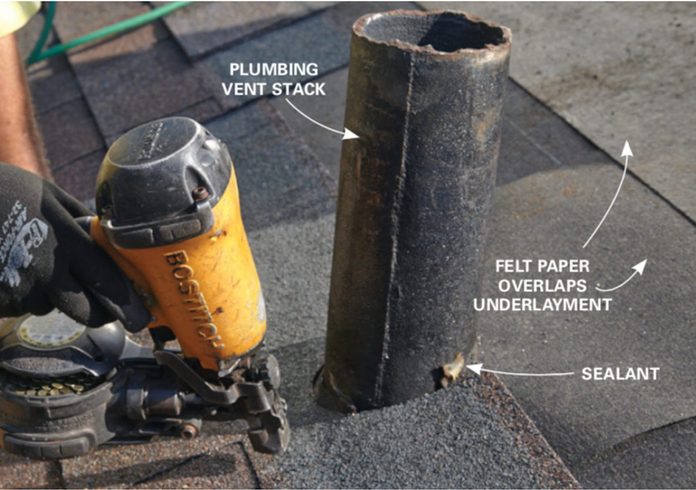
Install a layer of underlayment around vent pipes and caulk with roof sealant before shingling. Run shingles halfway past vents before installing vent flashing.
Step 12
Add the vent flashing
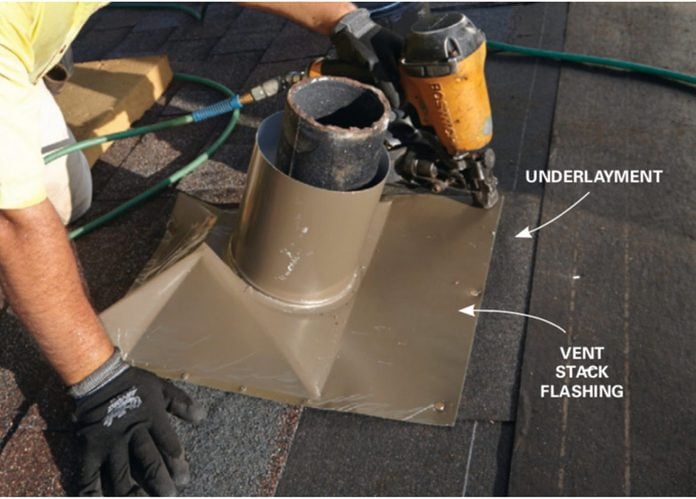
Drive three nails along the top edge of the flashing and one at each of the lower corners.
Step 13
Shingle over the vent flashing

Seal the nail heads, and trim around the stack flashing with a utility knife fitted with hook blades.
Step 14
Add ventilation
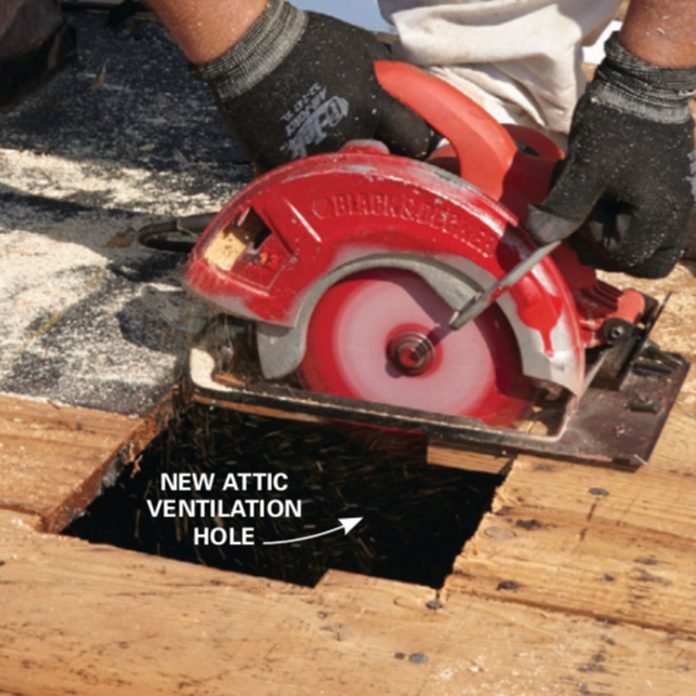
If you need more ventilation, cut additional vent holes in the decking with a circular saw and install vent flashing. Installing shingles around attic vents, plumbing vent stacks and furnace stacks is basically the same process. The main difference is that you'll install a piece of self-stick underlayment around all the stacks, but you just need to roll the felt paper over the vent holes and cut out the holes. When installing the felt paper over a stack, it's OK to make an oversize hole. But before you roll out the row of paper above the stack, cut a 2- or 3-ft. section of self-stick underlayment, cut a hole in it slightly smaller than the diameter of the stack, and slide it over the stack. Make sure the piece is large enough so that the next row of felt paper overlaps the top at least a couple of inches (Photo 12). Caulk around the pipe when you're done.
Install the shingles up and halfway past the vent hole or stack. Next, install your vent or stack flashing over that row of shingles (Photo 13). Nail it down with your roofing gun, top and bottom.
Seal the top nail holes and continue on up with your shingles. Trim the shingles with your utility knife (Photo 14). Some vent and stack flashing is covered in protective plastic, which will have to be removed.
If you're installing the type of stack flashing with a rubber boot that seals around the pipe, spray-paint the pipe a similar color as your roof. You can also paint electrical masts and other projections (before installing shingles). This simple step adds a lot to the finished look of your roof.
To find out if you have proper attic ventilation, search attic ventilation calculator (GAF has one version). Just type in the dimensions of your attic to learn how many vents you need. If you don't have adequate ventilation, cut in more holes with a circular saw (Photo 15).
Step 15
Cap the ridge
Cap the ridge
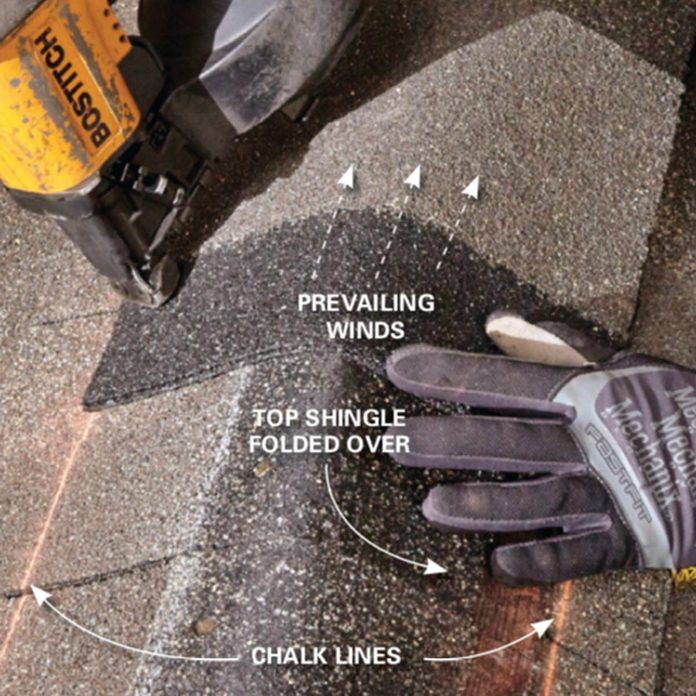
Snap chalk lines to help keep the row of ridge cap shingles straight. Install the ridge cap so the prevailing winds blow over the overlap seams, not into them. Once all your shingles are installed, you'll need to cover (cap) the ridge (and hip ridges if you have a hip roof). The top ridge cap shingles will overlap the hip ridge cap, so start with the hips. Snap a couple of guide lines just a little inside the perimeter of the ridge so the lines get covered up when you're done. Nail each shingle on both sides about 1 in. above the overlap seam (Photo 16). Store-bought architectural-style ridge caps are often two layers thick, to match the look of the shingles. You may need longer nails to fasten the ridge because of all the extra layers of shingles.
Install the top ridge cap so the prevailing winds blow over the overlaps rather than into them. If wind isn't an issue, start at either side, or start at both sides and end in the middle. Rip the top half off the last ridge cap shingle, and nail through the face of it with two nails on the ends of each side.
Seal it up
Before you put your ladder away, sweep all the debris off the roof, and then seal all the exposed nails on your vents and stack flashing. If you used stack flashing that has the rubber boot, seal the area where rubber meets the pipe. Avoid silicone (it won't hold up) and asphalt-based sealants (they tend to dry out when exposed to direct sunlight). Our roofers prefer a product called Lexel available through our affiliation with Amazon.com. It's clear like silicone, sticky as model glue and lasts for years. And remember, these areas you sealed require maintenance—they should be inspected every few years.
Originally Published: July 24, 2021
Source: https://www.familyhandyman.com/project/how-to-roof-a-house/
0 Response to "Easy on the Job Tough the Elements Roofing or Roof"
Post a Comment